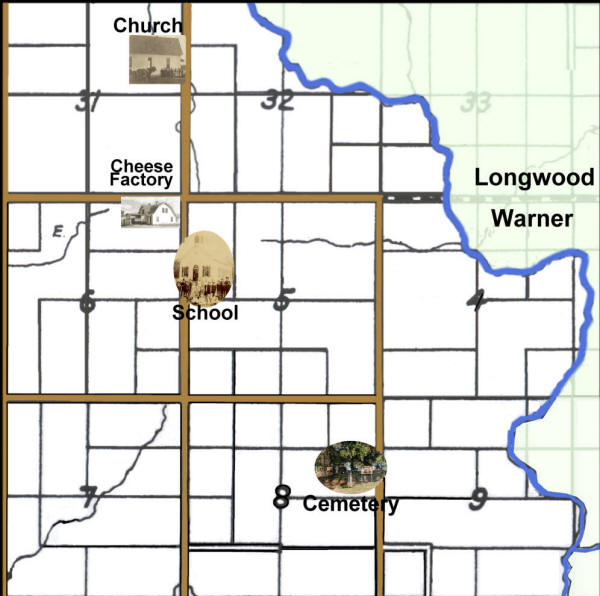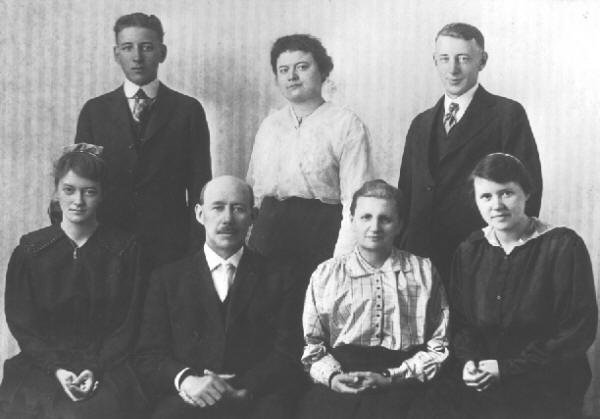Warner Township
Clark County, Wisconsin
Braun Settlement History
I was raised in a community of German immigrants known as "The Braun Settlement". As a young boy, it seemed strange to me that it wasn't called "The Horn Settlement" because by the time I was born, there were far more Horns than Brauns farming those area fields. Like nearly all the off-spring from that neighborhood, I have the blood of both families running through my veins. From my earliest days, I knew that nearly all of our area pioneers had descended from the same ancestry and were blood related. However, it wasn't until 1958 when I was a University of Wisconsin Student, that I first heard our relationship referred to as a "consanguine family".
-
1900 - 1958 Horn Family Farms (Braun Settlement)
Around 1877, several members of both the Horn and Braun families moved to Clark County and homesteaded west of the Black River which runs through Greenwood, Wisconsin. William Braun II and his wife Anna Torsh were the first homesteaders in the area. They had 9 children, two died in infancy. The other seven were three girls, Eva, Louisa, and Christina. The four boys were Christian, Fredrick, William III, and Gottfried. My grandfather, Robert Horn, married Christina Braun. His brother, Frank, married Louisa (sister of Christina). Emilie Horn (sister of Robert & Frank) married William Braun III (brother of Louisa and Christina). Fredrick Braun married Maria Wilck and his brother, Christian, married Elisa Wilck, sister of Maria. Since the Brauns outnumbered the Horns in the beginning, the area became known as "The Braun Settlement" and is still called that to this day. The Wilcks, (and who else?) also were amongst the earliest to settle there. Also what sections of Warner are we referring to here?
My grandparents, Robert and Christina (Braun) Horn , were devoutly, religious folks who were raised as Lutherans. They brought that faith with them when they came to this country with their parents and first settled in Sheboygan, Wisconsin.
By 1900, there were only two Horn families living in the entire vicinity. As destiny would have it, they intermarried with the Braun family to the point that the early maps listed far more property owners with the Horn surname. Typical to most small mid-western communities, this one built their own church and school. Those too, were identified by "The Braun Settlement" name. The history of the Salem Braun Settlement Reformed Church confirms the family's search for truth and an unwillingness to simply accept religion as a mere inheritance. It served as a hub for the community activities where new babies were blessed and where we said our goodbyes to family members before burying them a little over two miles away in the Forest Hill Cemetery. Of course the congregation's story is also a family story and since I heard it from two different sources, I've assumed it is more factual than fiction.
The only Lutheran church serving the needs of these early pioneers, was located in Wausau, Wisconsin and about once a month their pastor conducted services in one of the area homes.
In early August, 1890, the fifty two year-old mother-in-law of Christian and Frederick Braun, Maria Wilck, became quite ill and requested communion. The Lutheran pastor was summoned from Wausau, and upon arrival he asked for grape wine as he prepared to administer it. He was informed that while they had other wine in the home, there was no grape wine. Extremely upset that a proper wine could not be found, this man of God refused to give his blessing and promptly left. He had come such a long way only to abandon the purpose for his trip and disappoint the fledgling congregation. How could they possibly respect a representative of Jesus, with such shallow understanding? Did this teacher know that Jesus had turned water into wine? Where in the bible was grape wine declared more scared than any other? Did this man's God really care more about the type of wine a clergymen used for communion than comforting a human soul?
Louisa (Braun) Horn, a sister of my grandmother, who was not easily discouraged, believed a proper minister would grant the requested sacrament. On August 6, 1890, she hitched a horse to their buggy and made the six mile trip to the closest neighboring Church. The denomination was German, but not Lutheran. Their pastor, Rev. John Schmalz, had served them well for past two years and his growing flock was making plans to build a new brick church. Those parishioners had first organized in January 11, 1874, under the umbrella of the Reformed religion. Like the Braun's and the Horn's, many of them had initially immigrated to Sheboygan County, WI. The denomination's beliefs are rooted in the Presbyterian doctrine of predestination. They claimed Jesus as their Savior and, like the Lutheran's, a salvation by grace, not by works. Of course, the more crucial factor at the time was their belief in the Holy Communion. Louisa asked if he would give the sacrament to the gravely ill Lutheran using fruit wine instead of grape wine. Without hesitation, he agreed to do so, saying, "The wine makes no difference. Even water can be used to represent the blood of Christ. It is Maria's faith in the Lord that matters most". With that, he went to Maria's bedside and gave her the communion cup and blessed her. Later that evening, Maria passed away, knowing the Lord had answered her prayers. She was the first person laid to rest in Forest Hill Cemetery. This gave great satisfaction to the families, but not the Lutheran pastor. He felt insulted and said that they had done wrong and that he could no longer preach to them because they had called in a Reformed minister. From that time on, there was no reason for the Lutheran Clergyman to ever visit again. Their beloved minister, Rev. John Schmalz, now lived just six miles down the road and when the time came, they would build a Reformed church, not a Lutheran one.
So it came that these neighbors invited the Reformed pastor to conduct services for them. He agreed and on August 23, 1891, he had his first sermon in the Gotfried Braun home. On September 10th, eight families joined together and decided to form as a body, by rule and order of the Sheboygan Klassis of the Reformed Church. After that, the Reformed pastor came every fourth Sunday in the afternoon and conducted services in the Braun Settlement school.
At a school meeting on July 7, 1903, it was voted that the school should no longer be used for church service or Sunday school, On September 13, 1903, at a church meeting, plans were made to build a Reformed Church in the community. My Grandfather donated the land for this project and a total of $848.50 was raised for a church fund. In 1904 the church was built, and on October 2 it was dedicated to the glory of God.
Today that small Reformed church no longer exists, but many of the Horn and Braun families who still live in Braun Settlement belong to the Reformed Church (Now known as the United Church of Christ) from which the pastor came to give communion to a dying relative so many years ago.
The Braun Settlement School stood as a testimony to the importance which was placed on education by this extended family.
The families were of German stock, most of them settled in other areas, including Sheboygan County, Wisconsin. before settling in this particular community. Although English was spoken by the first generation, many of the conversations were held in German. Church services, including weddings and funerals, were conducting in German. The second generation could speak and understand the native German tongue, but it was hardly ever used except in rare instances. My Dad always gave the evening prayer in German, but Mom was Norwegian and I and my siblings didn't have enough contact with the language to know what he was saying. To help clear up the various generations of which I speak, I consider myself the third generation. My Grandparents would be the first and my parents the second generation. Although my great grandparents, Wilhelm and Anna Braun, did live in the settlement for a period of time.
The area in 1900 could be considered a forest area. The majority of each farm was in second growth timber. The railroad company had taken all the first growth of pines out of the area and the only sign left at this time of the once beautiful pines groves were blacken stumps and fallen logs left to rot by the company. The second growth of trees were hard woods and most of them were taken out between 1850 and 1920. Today the timber standing is mostly of the third growth and once again it is reaching commercial value as lumber. In the late 1920's and early 1930's when the second generation of families began farming, much of the wooded area was destroyed to secure land for farming purposes.
Of the two original Horn families in this community, Frank Horn had seven children and Robert Horn had eleven. This number only includes the children who reached the age of adulthood. The Braun Settlement cemetery contains several graves of young children from both families. Only one of Frank Horn's sons settled in the neighborhood, while four of Robert Horn's sons settled in the area which is indicated on the enclosed map of 1930. Most of the second generation children who settled in the settlement married into families which lived within a distance of two or three miles of their home. This furthered the entanglement of the consanguine family. On the map of 1930, along with the Brauns and Horns, the consanguine family also included the Liebzeit, Damerow, Buker, Woepse families or farms. Some members of the Horn & Braun family married into these families. It was during this period that the dairy industry became the chief occupation of the residents.
Most of the people of this enlarged family attended the Braun Settlement church. It was a Protestant church of the Dutch Reformed denomination. The social ties were very close, especially among the Horn families. Everything from grain drills and corn planters to cement mixers and Corn Shellers were purchased in partnership. Two or three of the farmer brothers would buy a piece of machinery between them and thus save each farmer from buying one. This could be a source of bitter conflict, but it worked out surprisingly well. Today the tendency is for father and son to buy machinery together. Getting back to religion, in about 1951 the Braun Settlement Church closed and a majority of its members joined the Reformed church six miles south of the community. But the group was still together socially. Whenever there was a wedding, card party or a similar function within the neighborhood, chances were that most members of the Braun Settlement Church were invited. After all most were members of the consanguine family.
Around 1950, the first of the third generation began putting their names on the neighborhood mailboxes. And it is this third generation which is taking over the neighborhood as shown by the 1950 map. Social relations between the families were very good. It is rapidly becoming Gesellschaft in nature because of this third generation. All of the children of this generation graduated from high school and many went on to college. Some of the boys also attended the farm short course at the University of Wisconsin. There they learned the latest methods and procedures of farming and put those practices into use, once they secured their own farms.
Sources: "Consanguine Family" by Duane Horn, March 24, 1958; Greenwood Gleaner Obituaries and News Clips.
Braun Settlement Time-Line
Braun Settlement Biographies
Related Links


